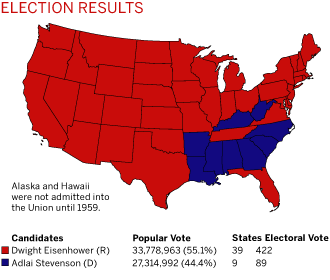1952 Eisenhower VS. Stevenson
"Ike for President"
Transcript
The Living Room Candidate - Transcript
"Ike for President," Eisenhower, 1952
[TEXT: A PAID POLITICAL ANNOUNCEMENT. PAID FOR BY Citizens for Eisenhower.]
[TEXT: EISENHOWER FOR PRESIDENT]
GROUP (singing): Ike for president, Ike for president,
Ike for president, Ike for president.
You like Ike, I like Ike,
Everybody likes Ike—for president.
Hang out the banners, beat the drums,
We'll take Ike to Washington.
We don't want John or Dean or Harry.
Let's do that big job right.
Let's get in step with the guy that's hep.
Get in step with Ike.
You like Ike, I like Ike,
Everybody likes Ike—for president.
Hang out the banners, beat the drums,
We'll take Ike to Washington.
We've got to get where we are going,
Travel day and night-for president.
But Adlai goes the other way.
We'll all go with Ike.
You like Ike, I like Ike,
Everybody likes Ike-for president.
Hang out the banner, beat the drums,
We'll take Ike to Washington.
We'll take Ike to Washington.
Ike for president, Ike for president, Ike for president, Ike for president...
[TEXT: VOTE FOR EISENHOWER]
MALE NARRATOR: Now is the time for all good Americans to come to the aid of their country. Vote for Eisenhower.
Credits
"Ike for President," Citizens for Eisenhower, 1952
Maker: Roy Disney
Video courtesy of the Dwight D. Eisenhower Presidential Library.
From Museum of the Moving Image, The Living Room Candidate: Presidential Campaign Commercials 1952-2012.
www.livingroomcandidate.org/commercials/1952/ike-for-president (accessed December 22, 2024).
Save
| 1952 | Eisenhower | Stevenson | Results |
Stevenson proved to be no match for the Republican nominee, war hero Dwight D. Eisenhower, who played a key role in planning the Allied victory in World War II. A poll in March 1952 found Eisenhower the most admired living American, and in November he won a landslide victory on the basis of his pledge to clean up "the mess in Washington" and end the Korean War.
Richard Nixon for vice president
"It’s Time for a Change"
In 1952, there was no precedent in presidential elections for the use of television "spot" advertising—short commercials that generally run between twenty seconds and a minute. Governor Thomas Dewey, declaring spots "undignified," rejected their use in his 1948 presidential campaign. In 1952, most campaign strategists preferred thirty-minute blocks of television time for the broadcast of campaign speeches. What distinguished Eisenhower’s campaign from Stevenson’s was that it relied more on spot ads than on speeches. The campaign pioneered their use with a series of ads titled "Eisenhower Answers America."
The idea for the spots came from Madison Avenue advertising executive Rosser Reeves, who had created the M&M "melts in your mouth, not in your hands" campaign. Reeves convinced Eisenhower that spot ads placed immediately before or after such popular TV programs as I Love Lucy would reach more viewers, and at a much lower cost, than half-hour speeches.
In each of the simple, twenty-second spots, Eisenhower responded to a question from an "ordinary citizen." The questioners—tourists enlisted near Radio City Music Hall—were photographed looking up, as though gazing at a hero. Eisenhower’s folksy responses, which he read from large cue cards, were used to create forty commercials, all filmed in one day in a Manhattan studio. The spots were designed to establish Eisenhower as a plainspeaking man in touch with the people. They repeatedly focused on three issues cited by polls as the voters’ main concerns: the Korean War, corruption in government, and the high cost of living.
John Sparkman for vice president
"You Never Had It So Good"
Speaking about the role of television advertising in election campaigns, Adlai Stevenson said, "I think the American people will be shocked by such contempt for their intelligence. This isn’t Ivory Soap versus Palmolive." Stevenson aide George Ball bitterly predicted that "presidential campaigns will eventually have professional actors as candidates."
Stevenson based his television strategy on a series of eighteen half-hour speeches that aired on Tuesday and Thursday nights at 10:30. The goal was to take advantage of Stevenson’s oratorical skills and build his national recognition by developing a regular audience for the broadcasts. But the lateness of the time slot cut down on the number of potential viewers, and the actual audience consisted largely of people already predisposed to vote for Stevenson.
Stevenson’s spot ads were little more than illustrated radio spots. The crude visuals generally consisted of a single shot, such as the simple cartoon drawing that illustrates the Ike and Bob ad, which implied that an Eisenhower presidency would be under the control of conservative Republican Robert Taft. Rather than defend the Truman administration, the ads attempted to distance Stevenson from it. Several of them reminded voters of how bad things were during the Depression, presided over by the last Republican president, Herbert Hoover.
Stevenson never warmed up to the medium during the campaign. He refused to appear in his own spots, and his speeches, which were aired live, frequently ran too long; the broadcast would fade out while he was still talking. In his election-eve special, when his son tells him, "I like watching television better than being on it," Stevenson replies, "I guess that goes for all of us, doesn’t it?"



















